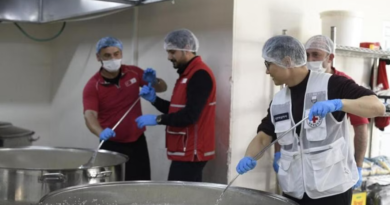5 Best Herbs for Growing in Containers
.
:max_bytes(150000):strip_icc():format(webp)/GettyImages-668764803-4880afd6f31348c19224668fdc0ff906.jpg)
Westend61/Getty Images
,
5 Best Herbs for Growing in Containers
:max_bytes(150000):strip_icc():format(webp)/GettyImages-668764803-4880afd6f31348c19224668fdc0ff906.jpg)
Container gardening is a great way to have more control over the herbs you grow. You can easily move the containers towards a warmer, sunnier area if needed, then back into the shade if the season gets too hot. Container herbs are more readily available when they are grouped together, and you will be more apt to use them when they are right outside your kitchen door, growing in containers. Finally, there are some herbs that are frankly so aggressive in their growth habits that it’s best to confine them in a container where they can be controlled.
Here are our five choices for the herbs best suited for growing in containers.
-
01of 05
Mint (Mentha spp.)
:max_bytes(150000):strip_icc():format(webp)/GettyImages-947759838-5aadc9362c064ceeaa0bd6c59598d051.jpg)
Francesco Carta fotografo/Getty Images - USDA Growing Zones: 3 to 11
- Sun Exposure: Full sun to part shade
- Soil Needs: Rich, moist soil
Mint is notorious for being unruly when planted in the garden. You plant one and soon 20 will follow, and a garden takeover is in the offing. Different varieties of mint also have an annoying habit of cross-pollinating, producing hybrids you don’t want.
Planting mint in containers solves these problems. Individual varieties can be kept far enough apart so that your pineapple mint won’t suddenly start tasting like catnip/pineapple. And mint confined in a container stays there—it doesn’t spread rampantly through your garden.
When it comes to choosing the best herbs for container gardening, mint should be your first choice.
-
02of 05
Sage (Salvia officinalis)
:max_bytes(150000):strip_icc():format(webp)/GettyImages-505154322-930765933a8f4db185a377524823eb83.jpg)
Flavia Morlachetti/Getty Images - USDA Growing Zones: 4 to 8
- Sun Exposure: Full sun to part shade
- Soil Needs: Dry to medium-moisture, well-drained soil
Culinary sage is an herb best planted in a container because its care needs are more readily accomplished if you keep it nearby, in plain sight. Sage requires a lot of pinching and cutting to keep it from becoming woody, and it needs to be replanted every three years or so. You’re much more likely to stay ahead of the necessary maintenance if the plants are kept in containers where you see them regularly.
Sage dries very well and if you pinch the leaves throughout the growing season, put a rubber band on them, and keep them safe after drying, by the end of the season you will have enough bundles to make an herb wreath—a lovely gift that requires very little effort.
-
03of 05
Rosemary (Rosmarinus officinalis)
:max_bytes(150000):strip_icc():format(webp)/grow-and-care-for-rosemary-plants-1403406-light-ea1fb8d945aa4364b7c84989f7235f2d.jpg)
The Spruce / Leticia Almeida - USDA Growing Zones: 9 to 11 (grown as an annual elsewhere)
- Sun Exposure: Full sun
- Soil Needs: Sandy soil
Rosemary is a favorite herb for many people. It dries perfectly, holds its strong taste all winter, gladly comes indoors to continue growing in a sunny window, and is rarely bothered by insects. You can use rosemary for many herb standards or topiaries, and the woody stems are perfect for crafting. The stems can also be used as skewers—keep the stems in the freezer and use them as grilling skewers.
Rosemary prefers sandy soil, and it doesn’t like to sit in water but prefers to dry out between waterings. Being in its own container allows you to address its specific growing needs more efficiently.
-
04of 05
Basil (Ocimum basilicum)
:max_bytes(150000):strip_icc():format(webp)/GettyImages-945032674-c3752646fca0439f93efedf6054cf269.jpg)
Francesco Carta fotografo/Getty Images - USDA Growing Zones: 10 to 11 (grown as an annual elsewhere)
- Sun Exposure: Full sun
- Soil Needs: Rich, well-drained soil
Basil is one of the most rewarding herbs to grow in a container. It likes to have plenty of water to keep its fleshy stems and tender leaves plump but is susceptible to mildew. In a container, you can position the plant so that it gets plenty of air-flow. Basil also likes a somewhat richer soil than most other herbs, which you can tailor through a custom-mixed potting soil. Basil is often used with recipes calling for tomatoes, so it is often grown in a container near a potted tomato plant on the patio.
-
05of 05
Thyme (Thymus vulgaris)
:max_bytes(150000):strip_icc():format(webp)/GettyImages-506724063-4ea2da1fcc5443a98b1d957d46b17bc4.jpg)
PicLeidenschaft/Getty Images - USDA Growing Zones: 5 to 10
- Sun Exposure: Full sun
- Soil Needs: Dry to medium-moisture soil
Thyme tends to be an undervalued herb that gets planted but rarely used. It actually deserves a much higher standing on the list of culinary herbs, and growing it a container is one way to keep it front and center. Thyme will thrive in a container environment, needing only minimal watering. Some varieties grow into small shrub-like plants with tiny lovely purple flowers, ideal for enhancing an entrance. It is a very low-maintenance herb, but remember that thyme becomes woody after a few years. Keeping it in a container makes it easier to replace when needed.


:max_bytes(150000):strip_icc():format(webp)/Herbgarden-GettyImages-177358558-d7bb9e958bba4c5290cd055d325e67a0.jpg)
:max_bytes(150000):strip_icc():format(webp)/fresh-aromatic-culinary-herbs-in-white-pots-on-windowsill--lettuce--leaf-celery-and-small-leaved-basil--kitchen-garden-of-herbs--1064116816-0300284b3e8f422eb9ac70802b92149c.jpg)
:max_bytes(150000):strip_icc():format(webp)/germany--baden-wuerttemberg--mint--mentha--in-garden-503881099-21de29c308f44f7aa5d099c75f33aa2d.jpg)
:max_bytes(150000):strip_icc():format(webp)/herbs-529980568-d388e2409f934a9ba8f3364f2eabb030.jpg)
:max_bytes(150000):strip_icc():format(webp)/spathoglottis-plicata-orchid-481207692-51fc59e46ed04dc0831038f59dba3918.jpg)
:max_bytes(150000):strip_icc():format(webp)/pruning-hanging-basket-in-greenhouse-621919754-5a9f1a2b642dca0037a7f441.jpg)
:max_bytes(150000):strip_icc():format(webp)/field-of-lavender--166275777-ab06ae703d9046408cfc86eab1946e27.jpg)
:max_bytes(150000):strip_icc():format(webp)/171900383-56a47d5f3df78cf77282b058.jpg)
:max_bytes(150000):strip_icc():format(webp)/Herbgarden-GettyImages-177358558-d7bb9e958bba4c5290cd055d325e67a0.jpg)
:max_bytes(150000):strip_icc():format(webp)/Phormium_IES-59357fa93df78c08ab89680c.jpg)
:max_bytes(150000):strip_icc():format(webp)/GettyImages-155369078-3e56251c3b0141c9a1b92fbd4e1eccff.jpg)
:max_bytes(150000):strip_icc():format(webp)/Lemonbalmtea-GettyImages-820956782-664a98408c684c10bfb4b4d10981ed0e.jpg)
:max_bytes(150000):strip_icc():format(webp)/peony-flower-background-492863943-d993c5c8139a45058c99a6164960ab3c.jpg)
:max_bytes(150000):strip_icc():format(webp)/GettyImages-141861264-5b3540d8c9e77c0037962def.jpg)
:max_bytes(150000):strip_icc():format(webp)/viola-on-garden-table-in-flowerpot-601819907-a6b947ff4853445c94fa329556e1b140.jpg)
:max_bytes(150000):strip_icc():format(webp)/morning-glory-626751794-028f9167f6934e6eb33adc4fd064c649.jpg)
:max_bytes(150000):strip_icc():format(webp)/plants-with-daisy-like-flowers-2539985_FINAL-5b218fd13de4230037424a9f.png)







